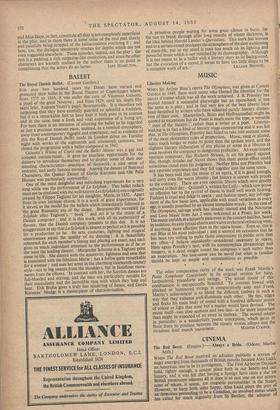MUSIC
Libretto- Making WHEN Sir Arthur Bliss's opera The Olympians, was given at Covent Garden in 1949, there were many who blamed the librettist for the succes d'estime which was all the work achieved. J. B. Priestley has proved himself a successful playwright but an opera-book is not the same as a play ; and in fact very few of the best libretti have been furnished by writers who have achieved purely literary distinc- tion of their own. Maeterlinck, Boito and Hoffmannsthal might be quoted as exceptions but da Ponte is much more the type, a versatile " man of the theatre " rather than a writer or a poet. Libretto- making is in fact a kind of literary stage-carpentering and it was felt that, in The Olympians, Priestley had failed to take into account some of the most elementary rules of proportion. Music, sung or played, i takes much longer to make its point than the spoken word, and the slightest literary elaboration of any phrase or scene in a libretto at once involves the composer in dangerous prolixities. An experienced operatic composer, like Richard Strauss, is on his guard against this, though Ariadne auf Naxos shows that sheer poetic effect could sometimes cloud even his judgment. Neither Bliss nor Priestley had any operatic experience and they fell together into the same snare. It has been said that the music of an opera, if it is good enough, will carry even the worst libretto ; but history is strewn with proofs to the contrary. There are even operatic libretti which were greatly admired in their day—Quinault's, written for Lully—which now prove an effective bar to the revival of music in itself well worth hearing. Fashion is cruel and fickle in opera ; and fashion apart, any infringe- ment of the few basic laws, applicable with small variations in every age, is usually punished by an almost immediate wreck. In the case of The Olympians, salvage work has already started and the Nocturne and Love Music from Act 2 were welcomed at a Prom. last week. The music unfolds at a leisurely pace even in the concert-hall but, heard in isolation, its easy lyrical charm and warm orchestral colouring were, if anything, more effective than in the opera-house. Even so, this is not Bliss at his most individual ; and it seemed on occasions that he has been too willing to make those concessions to public taste that are often—I believe mistakenly—considered necessary- in opera. Here again Priestley's text, with its commonplace phraseology and imagery, is a dead weight round the composer's neck rather than an inspiration. No love-scene can be novel but what is familiar should be kept as simple and unpretentious as possible.
The other comparative rarity of the week was Frank Martin's i Petite Symphonie Concertante in its original version for harp, harpsichord, pianoforte and strings. The actual sound of this combination is unexpectedly beautiful. To contrast bowed with plucked or hammered strings is comparatively easy and Frank Martin's achievement is to blend the different timbres in such a way that they enhance and illuminate each other. He tips, edges and flecks his main body of sound with a hundred different points of colour or light that none but a master would have devised. The music itself—two slow sections and two fast—is far more important than might be expected of an essay in timbres. The second adagio in particular, is a wonderfully poetic conception, which gains in force from its position between the closely woven allegro and the vivacious final march movement. MARTIN COOPER.


































 Previous page
Previous page